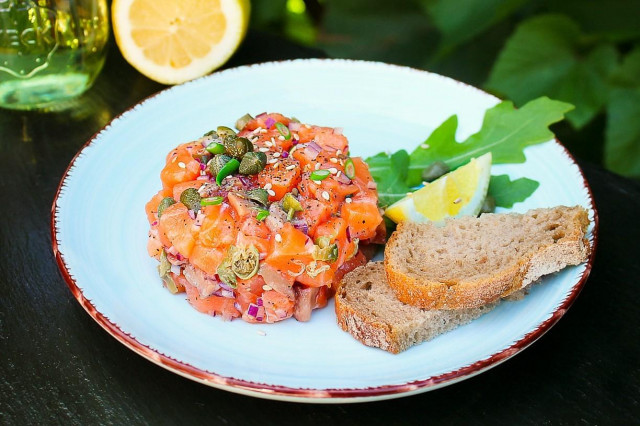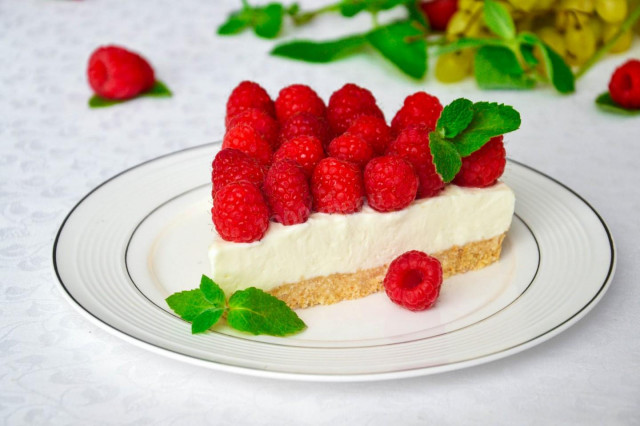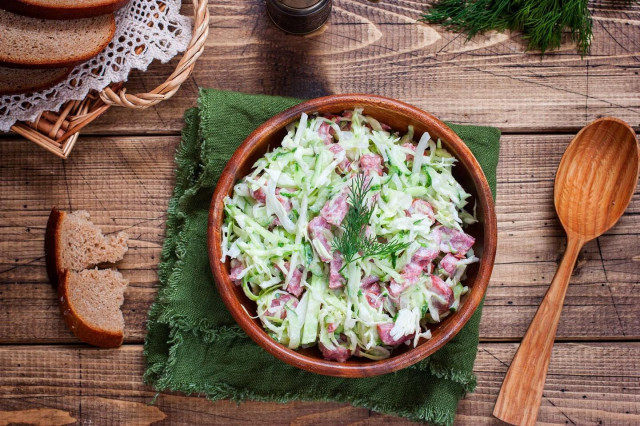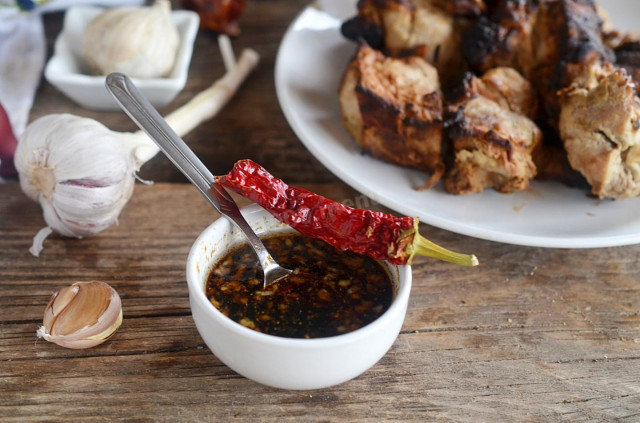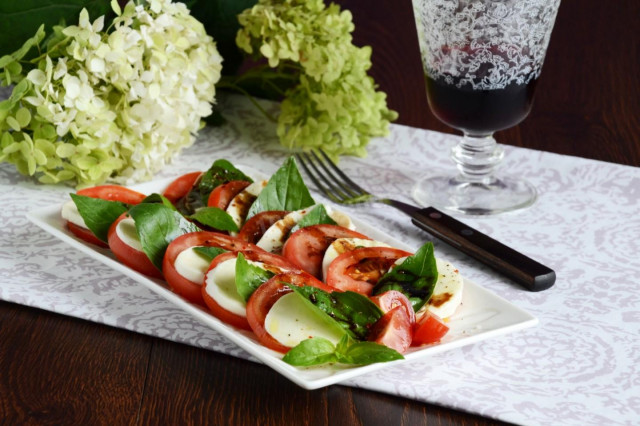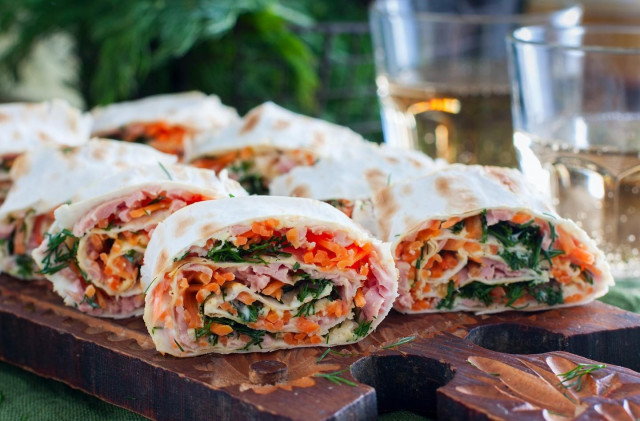Composition / ingredients
Step-by-step cooking
Step 1:

How to make salmon tartare? Prepare the products. It is best to cook tartare from fresh salmon fillet. Since the fish is not subjected to heat treatment during cooking, for safety, put a piece of salmon in the freezer for a while. In addition, it will be more convenient and faster to cut such fillets into uniform and identical pieces. If you have a whole fish, then cut it into fillets.
Step 2:
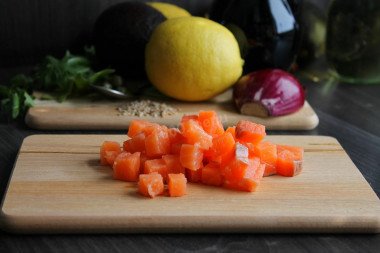
Wash the salmon fillet and remove the skin. Cut the fish into small cubes, about 0.5 cm by 0.5 cm. Or you can cut it into small even strips.
Step 3:

Peel the red onion, and then chop as finely as possible. For tartare, it is better to use red onions, shallots or white onions, these varieties of onions taste softer than ordinary onions and are ideal for salads.
Step 4:

Cut capers into 4-6 pieces.
Step 5:
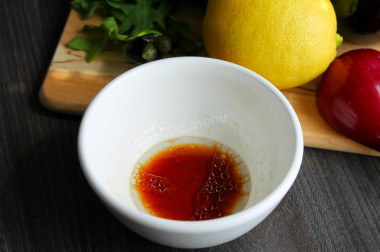
Prepare the dressing. To do this, add soy sauce, lemon juice and vegetable oil to a small bowl (you can safely use olive oil). Mix everything well.
Step 6:

Put the sliced fish fillet, red onion, capers, chopped chives (or green onions) in a deep dish. Sprinkle with ground allspice.
Step 7:
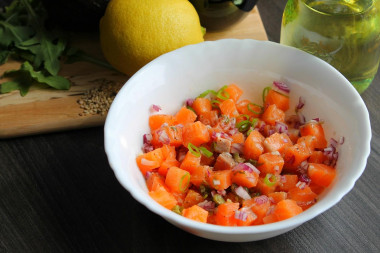
Add the dressing to the contents of the plate and mix everything thoroughly. Cover the tartare with cling film and send it to the refrigerator so that it is marinated and cooled. 20-30 minutes will be enough for this.
Step 8:
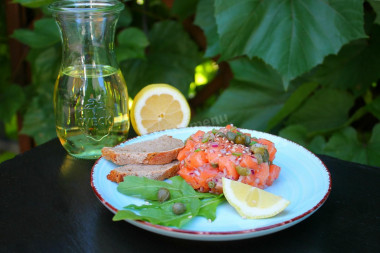
Put a few sprigs of arugula in a plate, place the tartare on top with a serving ring or gently with a tablespoon. If desired, sprinkle it on top with sesame seeds, lightly toasted in a dry frying pan. Serve the tartare with a slice of lemon and a slice of gray or black bread.
Step 9:

As you know, red fish goes well with avocado. The finished tartare will also be good and harmonious with this fruit. And how much use! Cut the avocado into small identical pieces, sprinkle with lemon juice so that the pieces do not darken, and put the fish tartare on top. Bon appetit!
In the recipe, instead of lemon, you can use lime and lime juice, this will give a special touch to the dish.
How to properly cut a whole fish into fillets? Remove the tail, head and fins. Cut the carcass along the spine to the spine. Turn it on its side. With a sharp knife, cut the meat from the backbone bone. Turn the carcass over and cut the fillet from the other side. Clean the inside by removing the black film, as it is bitter and will spoil the taste. Rinse and be sure to dry well.
Since the degree of salinity, sweetness, bitterness, sharpness, acid, burning is individual for everyone, always add spices, spices and seasonings, focusing on your taste! If you put some of the seasonings for the first time, then keep in mind that there are spices that it is especially important not to shift (for example, chili pepper).
So that the mucous membrane of the eyes is not irritated when slicing onions, rinse the onion and knife with cold water. The cutting board will not absorb the unpleasant onion smell if you rub it with a piece of lemon before slicing.
Caloric content of the products possible in the composition of the dish
- Minced salmon - 130 kcal/100g
- Smoked salmon - 162 kcal/100g
- Grilled salmon - 283 kcal/100g
- Fresh salmon - 201 kcal/100g
- Salted salmon - 269 kcal/100g
- Salmon saute - 379 kcal/100g
- Onion - 41 kcal/100g
- Lemon - 16 kcal/100g
- Lemon zest - 47 kcal/100g
- Avocado - 208 kcal/100g
- Soy sauce - 51 kcal/100g
- Vegetable oil - 873 kcal/100g
- Canned capers - 23 kcal/100g
- Capers - 23 kcal/100g
- Dried whole sesame seeds - 563 kcal/100g
- Shelled sesame seed - 582 kcal/100g
- Lemon juice - 16 kcal/100g
- Arugula - 25 kcal/100g
- Chives - 30 kcal/100g
- Allspice - 263 kcal/100g

